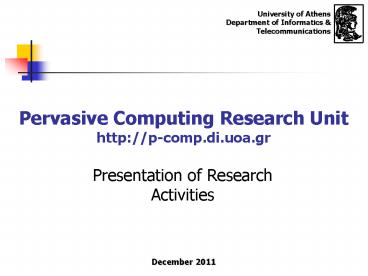Pervasive Computing Research Unit http://p-comp.di.uoa.gr - PowerPoint PPT Presentation
Title:
Pervasive Computing Research Unit http://p-comp.di.uoa.gr
Description:
Title: Pervasive Computing Research Group (p-comp) Author. Last modified by: vpap Created Date: 11/18/2004 2:51:49 PM Document presentation format – PowerPoint PPT presentation
Number of Views:143
Avg rating:3.0/5.0
Title: Pervasive Computing Research Unit http://p-comp.di.uoa.gr
1
Pervasive Computing Research Unithttp//p-comp.di
.uoa.gr
University of Athens Department of Informatics
Telecommunications
- Presentation of Research Activities
December 2011
2
Pervasive Computing Research Unit
- 20 members (faculty, Ph.D. candidates,
postdoctoral researchers, M.Sc. and B.Sc.
students) - Research Unit within NKUA Communications Network
Lab (http//cnl.di.uoa.gr) - Web site http//p-comp.di.uoa.gr
3
Research Interests
- Many different aspects of Pervasive Computing
- Context-aware and location-based services
(modeling, middleware, applications, smart
spaces) - Ontology-based knowledge engineering with
Semantic Web technologies - Algorithmic issues in Pervasive Computing (e.g.,
Game Theory, Optimal Stopping Theory, Statistical
Learning, Epidemical Diffusion, PSO - context
prediction, compression, diffusion) - Wireless Sensor Networks (middleware
information management, sensor data fusion) - Trust management architectures for autonomic
networks - Personalized Multimedia Communications,
intelligent services and middleware
4
PoLoS An integrated platform for location-based
services
- IST STREP Project http//polos.di.uoa.gr
- Middleware for creation, deployment and provision
of LBS - Portable, scalable and platform-independent
solution for LBS lifecycle management - Complex business models
- Connects to GIS, positioning servers and other
network facilities (SMS Gateways) through open
APIs (Parlay-X)
5
Polysema Semantics-based multimedia applications
framework
- Based on a smart residential gateway for
user-oriented multimedia content presentation
(DVB, Web, VoD) - Integrates multimedia meta-data and semantics
(MPEG-7 Semantic Web) - Extract semantic information from subtitles
- Uses Semantic Web technologies (OWL) for
user-oriented multimedia content retrieval and
presentation - Modeling and managing user profile preferences
- Supports MHP applications and APIs
(Internet-based systems)
6
MNISIKLIS Universal LBS for Indoor Environments
- National project
- Adopts a pure user-centered perspective (e.g.,
LBS services for disabled/elderly people) - Semantic Web technologies used for modeling and
reasoning about - Location, users, devices, content presentation
- Rich positioning infrastructure
- Dead reckoning, passive RFID, WiFi positioning
- Multimodal and adaptive user interfaces
- Voice directions, textual directions, maps,
7
SCIER Sensor and Computing Infrastructure for
Environmental Risks
8
SCIER details
- IST project on the management of natural hazards
at the Urban-Rural-Interface (URI) - Real-time monitoring of environmental phenomena
- Key technologies
- Autonomic sensor networks
- Information fusion techniques
- Mathematical and GIS-based environmental models
- GRID infrastructure for efficient data analysis
- Alerting and communication systems
- WWW site http//www.scier.eu
9
IPAC Integrated Platform for Autonomic Computing
- FP7 ICT Project
- Middleware and service creation environment for
embedded, intelligent, collaborative,
context-aware services in mobile nodes - IPAC scope diverse applications in a
collaborative nomadic environment - Humanitarian Relief Operations
- Industrial Environments
- Intelligent Transportations
- IPAC services are supported by knowledge and
ontology engineering techniques, dealing with
interoperability, integration, and
re-configuration/adaptation issues - WWW site http//ipac.di.uoa.gr/
10
IPAC Environment
End Device
ED
Relaying Node
RN
11
Humanitarian Relief Operations
- E.g.
- Obstacle/Hazardous area avoidance
- Road availability, movement control
- Chemical detection, Ice alert
12
IDIRA Project
- FP7 SEC Project, 2011-2014, 18 partners
- Interoperability of data and procedures in
large-scale multinational disaster response
actions - IDIRA Scope provide an integrated solution to
support large-scale international cooperation in
emergency situations - Outcome set of tools, interfaces and procedures
- Trial Scenarios flood, earthquake/fire, pandemic
- WWW site http//www.idira.eu/
13
IDIRA Concept
- a conceptual framework that supports and
augments regionally available emergency
management capacities with a flexibly deployable
Mobile Integrated Command and control Structure
(MICS), which aims at supporting co-ordinated
large-scale disaster management
14
IDIRA Ecosystem
15
Other Activities
- Knowledge management and reasoning in embedded
devices - Machine learning
- Machine Vision
- Indoor positioning systems
- Applications in healthcare (pervasive
healthcare), geo-sciences, etc. - Multimodal and adaptive interfaces
- Research testbed development (WLAN,
indoor/outdoor positioning, Sensor platform).
16
Lab Equipment
- Short Range Communication platforms
- High- and low-frame rate cameras/vision sensors
- Weather stations
- Sunspots, Xbox Motes, CSEM WiseNodes
- mini DSP units
- RFID readers IRDA Beacons
- DVB-T distribution server and STB middleware
platform
17
Indicative publications
- C. Anagnostopoulos, S. Hadjiefthymiades, P.
Georgas, "PC3 Principal Component-based Context
Compression - Improving Energy Efficiency in
Wireless Sensor Networks", Journal of Parallel
and Distributed Computing, to appear, Elsevier,
October, 2011 - Christos Anagnostopoulos, Stathes
Hadjiefthymiades, Evangelos Zervas, "Information
Dissemination between Mobile Nodes for
Collaborative Context Awareness", IEEE
Transactions on Mobile Computing (vol. 99), IEEE
, August, 2011 - Christos Anagnostopoulos, Odysseas Sekkas,
Stathes Hadjiefthymiades, "An Adaptive Epidemic
Information Dissemination Model for Wireless
Sensor Networks", Elsevier, Pervasive and Mobile
Computing Journal, Elsevier (to appear),
Elsevier, August, 2011 - G. Alyfantis, S. Hadjiefthyiades, and L. Merakos,
"Exploiting User Location for Load Balancing
WLANs and Improving Wireless QoS", ACM
Transactions on Autonomous and Adaptive Systems
(TAAS), 4(2), , May, 2009 - C. Anagnostopoulos and S. Hadjiefthymiades,
"Enhancing Situation Aware Systems through
Imprecise Reasoning", in the IEEE Transactions on
Mobile Computing (TMC), vol. 7, no. 9, September
2008.































